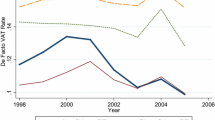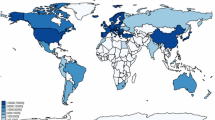Abstract
This paper explores the relationship between the closure of “antidumping jumping” manufacturing plants and the repeal of antidumping measures. Of 67 identified Japanese “antidumping jumping” production lines in the EU in 1990 only 31 remained in operation in 1999. Analysis of the probability of divestment for 209 Japanese plants in the broadly defined electronics industry shows that Japanese plants of manufacturing products for which antidumping duties had been repealed are significantly and substantially more likely to be divested. The results suggest that the potential positive effects of antidumping duties on host economies by inducing inward investment are in many cases short-lived and easily overestimated. JEL no. F23, F13, L11
Similar content being viewed by others
References
Azrak, P., and K. Wynne (1995). Protectionism and Japanese Direct Investment in the United States.Journal of Policy Modeling 17 (3): 293–305.
Barkema, H. G., J. H. J. Bell, and J. Pennings (1996). Foreign Entry, Cultural Barriers, and Learning.Strategic Management Journal 17 (2): 151–166.
Barrell, R., and N. Pain (1999). Trade Restraints and Japanese Direct Investment Flows.European Economic Review 43 (1): 29–45.
Belderbos, R. (1997a).Japanese Electronics Multinationals and Strategic Trade Policies. Oxford: Oxford University Press.
Belderbos, R. (1997b). Antidumping and Tariff Jumping: Japanese Firms' DFI in the European Union and the United States.Weltwirtschaftliches Archiv/Review of World Economics 133 (3): 419–457.
Belderbos, R. A. (2001). Overseas Innovations by Japanese Firms: An Analysis of Patent and Subsidiary Data.Research Policy 30 (2): 313–332.
Delderbos, R., and L. Sleuwaegen (1998). Tariff Jumping FDI and Export Substitution: Japanese Electronics Firms in Europe.International Journal of Industrial Organisation 16 (5): 601–638.
Belderbos, R., G. Capannelli, and K. Fukao (2001). Backward Vertical Linkages of Foreign Manufacturing Affiliates: Evidence from Japanese Multinationals.World Development 29 (1): 189–208.
Belderbos, R., H. Vandenbussche, and R. Veugelers (2003). Antidumping Duties, Undertakings, and Foreign Direct Investment in the EU. Forthcoming inEuropean Economic Review.
Benito, G. R. G. (1997). Divestment of Foreign Production Operations.Applied Economics 29 (10): 1365–1377.
Blonigen, B. (2000). Tariff Jumping Antidumping Duties. NBER Working Paper 7778. National Bureau of Economic Research, Cambridge, Mass.
Blonigen, B., and R. Feenstra (1997). Protectionist Threats and Foreign Direct Investment. In R. Feenstra (ed.),The Effects of U.S. Trade Protection and Promotion Policies. Chicago: NBER and Chicago University Press.
Buckley, P. J., and J.-L. Mucchielli (eds.) (1997).Multinational Firms and International Relocation. Cheltenham: Edward Elgar.
Bureau Van Dijk (ed.) (2001). Amadeus Database [Directory of European Company Reports]. Amsterdam: Bureau Van Dijk.
Bürger, P., and H. Green (eds.) (1991). Japanische Investitionen in Europa 1990 [Japanese Investments in Europe 1990]. Deutsche Industrie- und Handelskammer in Japan, Tokyo.
Caves, R. E. (1996).Multinational Enterprise and Economic Analysis. Cambridge, Mass.: MIT Press.
Caves, R. E. (1998). Industrial Organization and New Findings on the Mobility and Turnover of Firms.Journal of Economic Literature 36 (4): 1947–1982.
CEC (Commission of the European Communities) (1995–1999). Annual Report from the Commission to the European Parliament on the Community's Anti-Dumping and Anti-Subsidy Activities. Brussels.
Chang, S.-J. (1996). An Evolutionary Perspective on Diversification and Corporate Restructuring: Entry, Exit, and Economic Performance during 1981–89.Strategic Management Journal 17 (8): 587–611.
Denshi Keizai Kenkyujo (1993). Kaigai Seisan Shinshutsu Kigyou Joukyou: Ichiran Kunibetsu to Hinmokubetsu [Foreign Production: Overiview by Country and Product]. Denshi Jouhou, Publication 673. Denshi Keizai Kenkyujo, Tokyo.
Denshi Keizai Kenkyujo (1994–1998). Kaigai Seisan Shinshutsu Kigyou Joukyou: Shinshutsu. Genkyou. Tettai Nado [Foreign Production: Advance, Current Situation, and Divestment]. Denshi Jouhou (various issues). Denshi Keizai Kenkyujo, Tokyo.
Dunne, T., M. J. Roberts, and L. Samuelson (1988). Patterns of Firm Entry and Exit to U.S. Manufacturing Industries.Rand Journal of Economics 19 (4): 495–515.
Elsevier Science Publishers (1994, 1998).Yearbook of World Electronics Data. Vol. 1:West Europe. Amsterdam: Elservier Science Publishers.
Evans, D. S. (1987). The Relationship between Firm Growth, Size, and Age: Evidence for 100 Manufacturing Industries.Journal of Industrial Economics 35 (4): 567–581.
Geroski, P. A. (1995). What Do We Know about Entry?.International Journal of Industrial Organization 13 (4): 421–440.
Girma, S., D. Greenaway, and W. Wakelin (2002). Does Antidumping Stimulate FDI? Evidence from Japanese Firms in the UK.Weltwirtschaftliches Archiv/Review of World Economics 138 (3): 414–436.
Haaland, J., and I. Wooton (1998). Antidumping Jumping: Reciprocal Antidumping and Industrial Location.Weltwirtschaftliches Archiv/Review of World Economics 134 (2): 341–362.
Hennart, J.-F., D.-J. Kim, and M. Zeng (1998). The Impact of Joint Venture Status on the Longevity of Japanese Stakes in U.S. Manufacturing Affiliates.Organization Science 9 (3): 382–395.
JETRO (Japan External Trade Organization) (1989–1999). Survey on the Operations of Japanese-Affiliated Manufacturing Companies in Europe. JETRO, Tokyo.
Jovanovic, B. (1982). Selection and the Evolution of Industry.Econometrica 50 (3): 649–670.
Kogut, B. (1989). The Stability of Joint Ventures: Reciprocity and Competitive Rivalry.Journal of Industrial Economics 38 (2): 183–189.
Kogut, B., and N. Kulatilaka (1994). Operational Flexibility, Global Manufacturing, and the Option Value of a Multinational Network.Management Science 40 (1): 123–139.
Larimo, J. (2000). Divestment of Foreign Production Operations in Nordic Firms. Paper presented at the Annual AIB Conference in Phoenix, Arizona. November.
Li, J. (1995). Foreign Engry and Survival: Effects of Strategic Choices on Performance in International Markets.Strategic Management Journal 16 (5): 348–362.
Mata, J., and P. Portugal (2000). Closure and Divesture by Foreign Entrants: The Impact of Entry and Post-Entry Strategies.Strategic Management Journal 21 (5): 549–562.
Park, Y.-R., and S.-W. Park (2000). Determinants of FDI Survival: The Case of Korean Manufacturing Firms. Paper presented at the AIB Conference in Phoenix, Arizona, November.
Pennings, E., and L. I. E. Sleuwaegen (2000). International Relocation: Firm and Industry Determinants.Economics Letters 67 (2): 179–186.
Pennings, J., H. Barkema, and S. Douma (1994). Organizational Learning and Diversification.Academy of Management Journal 37 (3): 608–640.
Perrin, S. (2001). The Internationalization of Korean Electronics Firms: Domestic Rivalry and Tariff Jumping. In F. Sachwald (ed.),Going Multinational: The South Korean Experience with Direct Investment. London: Routledge.
Shaver, J. M. (1998). Accounting for Endogeneity When Assessing Strategy Performances: Does Entry Mode Choice Affect Survival?.Management Science 44 (4): 571–585.
Shaver, J. M., and F. Flyer (2000). Agglomeration Economies, Firm Heterogeneity, and Foreign Direct Investment in the United States.Strategic Management Journal 21 (12): 1175–1193.
Shaver, J. M., W. Mitchell, and B. Yeung (1997). The Effect of Own Firm and Other Firm Experience on Foreign Direct Investment Survival in the United States, 1987–1992.Strategic Managment Journal 18 (10): 811–824
Toyo Keizai Inc. (1990–2000).Kaigai Shinshutsu Kigyou Souran [Directory of Japanese Multinational Corporations]. Tokyo: Toyo Keizai Inc.
Toyo Keizai Inc. (1990b–1993b).Japan Company Handbook. Tokyo: Toyo Keizai Inc.
Yamawaki, K. (1997). Exit of Japanese Multinationals in U.S. and European Manufacturing Industries. In P. J. Buckley and J.-L. Mucchielli (eds.),Multinational Firms and International Relocation. Cheltenham: Edward Elgar.
Yamawaki, H. (1999). Who Survives in Japan: An Empirical Analysis of European and U.S. Multinational Firms in Japanese Manufacturing Industries. Working Paper. Anderson Graduate School of Management, UCLA, Los Angeles.
Author information
Authors and Affiliations
Corresponding author
About this article
Cite this article
Belderbos, R. Antidumping and foreign divestment: Japanese electronics multinationals in the EU. Rev. World Econ. 139, 131–160 (2003). https://doi.org/10.1007/BF02659611
Issue Date:
DOI: https://doi.org/10.1007/BF02659611




